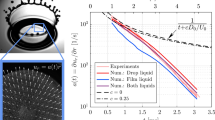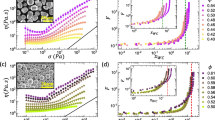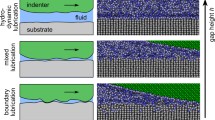Abstract
Melting of an ultrathin lubricant film under friction between atomically smooth surfaces is studied in terms of the Lorentz model. Additive noise associated with shear stresses and strains, as well as with film temperature, is introduced, and a phase diagram is constructed where the noise intensity of the film temperature and the temperature of rubbing surfaces define the domains of sliding, dry, and stick-slip friction. Conditions are found under which stick-slip friction proceeds in the intermittent regime, which is characteristic of selforganized criticality. The stress self-similar distribution, which is provided by temperature fluctuations, is represented with allowance for nonlinear relaxation of stresses and fractional feedbacks in the Lorentz system. Such a fractional scheme is used to construct a phase diagram separating out different types of friction. Based on the study of the fractional Fokker-Planck equation, the conclusion is drawn that stick-slip friction corresponds to the subdiffusion process.
Similar content being viewed by others
References
B. N. J. Persson, Sliding Friction: Physical Principles and Applications (Springer, Berlin, 1998).
H. Yoshizawa, Y.-L. Chen, and J. Israelachvili, J. Phys. Chem. 97, 4128 (1993); H. Yoshizawa and J. Israelachvili, J. Phys. Chem. 97, 11300 (1993).
E. D. Smith, M. O. Robbins, and M. Cieplak, Phys. Rev. B 54, 8252 (1996).
J. Krim, D. H. Solina, and R. Chiarello, Phys. Rev. Lett. 66, 181 (1991).
J. M. Carlson and A. A. Batista, Phys. Rev. E 53, 4153 (1996).
I. S. Aranson, L. S. Tsimring, and V. M. Vinokur, Phys. Rev. B 65, 125402 (2002).
P. A. Thompson and M. O. Robbins, Phys. Rev. A 41, 6830 (1990).
F. Family, M. O. Braiman, and H. G. E. Hentschel, Friction, Arching, Contact Dynamics, Ed. by D. E. Wolf and P. Grassberger (World Sci., Singapore, 1996), pp. 33–41.
Y. Braiman, H. G. E. Hentschel, F. Family, et al., Phys. Rev. E 59, R4737 (1999).
O. M. Braun and Yu. S. Kivshar, Phys. Rev. B 43, 1060 (1991).
J. B. Sokoloff, Phys. Rev. B 51, 15573 (1995).
T. Kawaguchi and H. Matsukawa, Phys. Rev. B 56, 4261 (1997).
A. V. Khomenko and O. V. Yushchenko, Phys. Rev. E 68, 036110 (2003).
A. V. Khomenko, Phys. Lett. A 329, 140 (2004).
P. Bak, How Nature Works: The Science of Self-Organized Criticality (Springer, New York, 1996).
A. I. Olemskoi, Physica A 310, 223 (2002).
C. Tsallis, in Lecture Notes in Physics, Ed. by S. Abe and Y. Okamoto (Springer, Heidelberg, 2001).
G. M. Zaslavsky, Phys. Rep. 371, 461 (2002).
Rheology: Theory and Applications, Ed. by F. R. Eirich (Academic, New York, 1956; Inostrannaya Literatura, Moscow, 1962).
H. Haken, Synergetics: An Introduction (Springer, Berlin, 1977; Mir, Moscow, 1980).
A. I. Olemskoi and A. V. Khomenko, Zh. Eksp. Teor. Fiz. 110, 2144 (1996) [JETP 83, 1180 (1996)].
H. Risken, The Fokker-Planck Equation: Methods of Solution and Applications, 2nd ed. (Springer, Berlin, 1989).
A. I. Olemskoi, Usp. Fiz. Nauk 168, 287 (1998) [Phys. Usp. 41, 269 (1998)].
D. J. Amit, Field Theory, the Renormalization Group and Critical Phenomena (McGraw Hill, New York, 1978).
R. Metzler and J. Klafter, Phys. Rep. 339, 1 (2000).
A._I. Olemskoi, A. V. Khomenko, and D. A. Olemskoi, Physica A 332, 185 (2004).
A. I. Olemskoi and D. O. Kharchenko, Physica A 293, 178 (2001).
A. Vespignani and S. Zapperi, Phys. Rev. Lett. 78, 4793 (1997); Phys. Rev. E 57, 6345 (1998).
A. I. Olemskoi and D. O. Kharchenko, J. Phys. Stud. 6, 253 (2002).
T. Hwa and M. Kardar, Phys. Rev. A 45, 7002 (1992).
A. Mehta and G. C. Barker, Rep. Prog. Phys. 57, 383 (1994).
A. I. Olemskoi and A. V. Khomenko, Phys. Rev. E 63, 036116 (2001).
A. Chessa, E. Marinari, A. Vespignani, et al., Phys. Rev. E 57, R6241 (1998).
S. G. Samko, A. A. Kilbas, and O. I. Marichev, Fractional Integrals and Derivatives: Theory and Applications (Nauka i Tekhnika, Minsk, 1987; Gordon and Breach, Amsterdam, 1993).
Author information
Authors and Affiliations
Additional information
__________
Translated from Zhurnal Tekhnichesko\(\overset{\lower0.5em\hbox{$\smash{\scriptscriptstyle\smile}$}}{l} \) Fiziki, Vol. 75, No. 11, 2005, pp. 17–25.
Original Russian Text Copyright © 2005 by Khomenko, Lyashenko.
Rights and permissions
About this article
Cite this article
Khomenko, A.V., Lyashenko, I.A. Stochastic theory of ultrathin lubricant film melting in the stick-slip regime. Tech. Phys. 50, 1408–1416 (2005). https://doi.org/10.1134/1.2131946
Received:
Issue Date:
DOI: https://doi.org/10.1134/1.2131946




